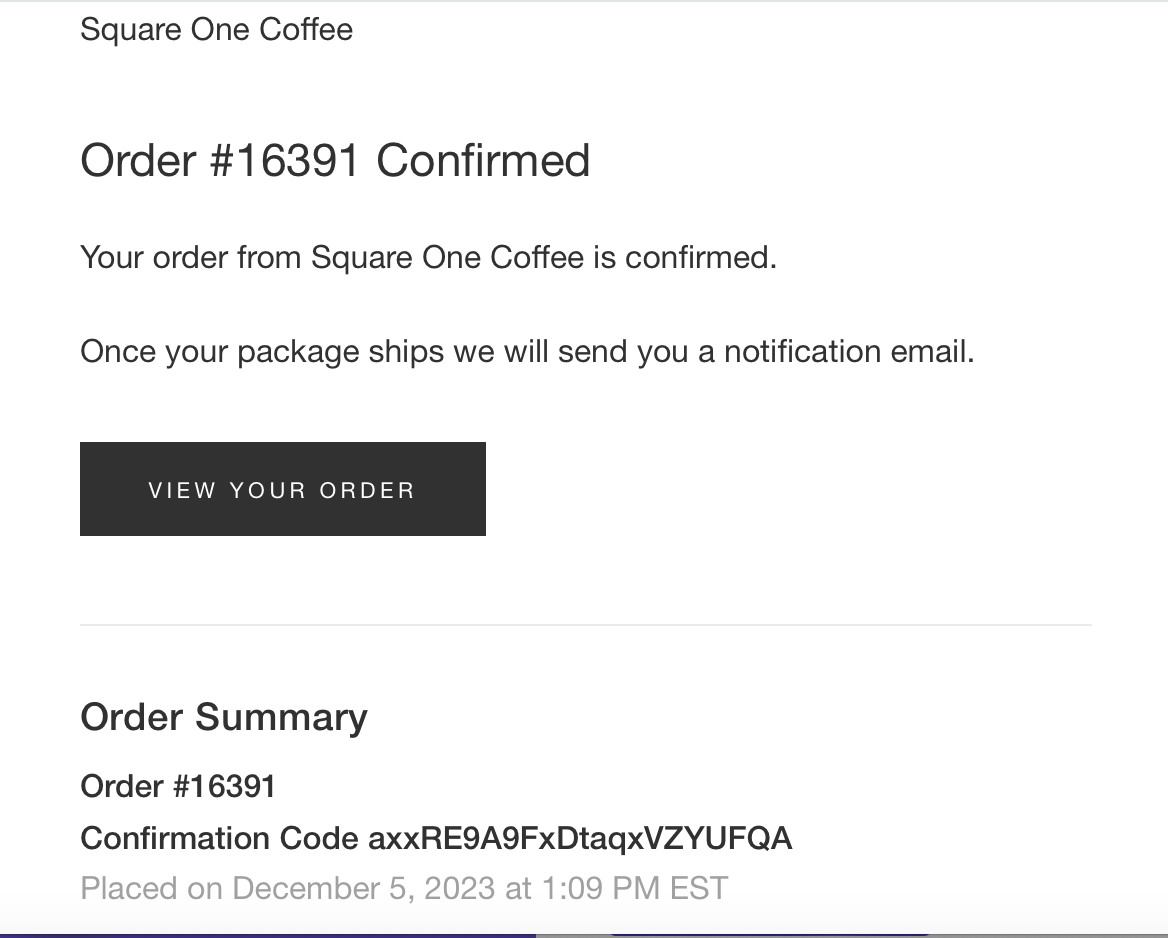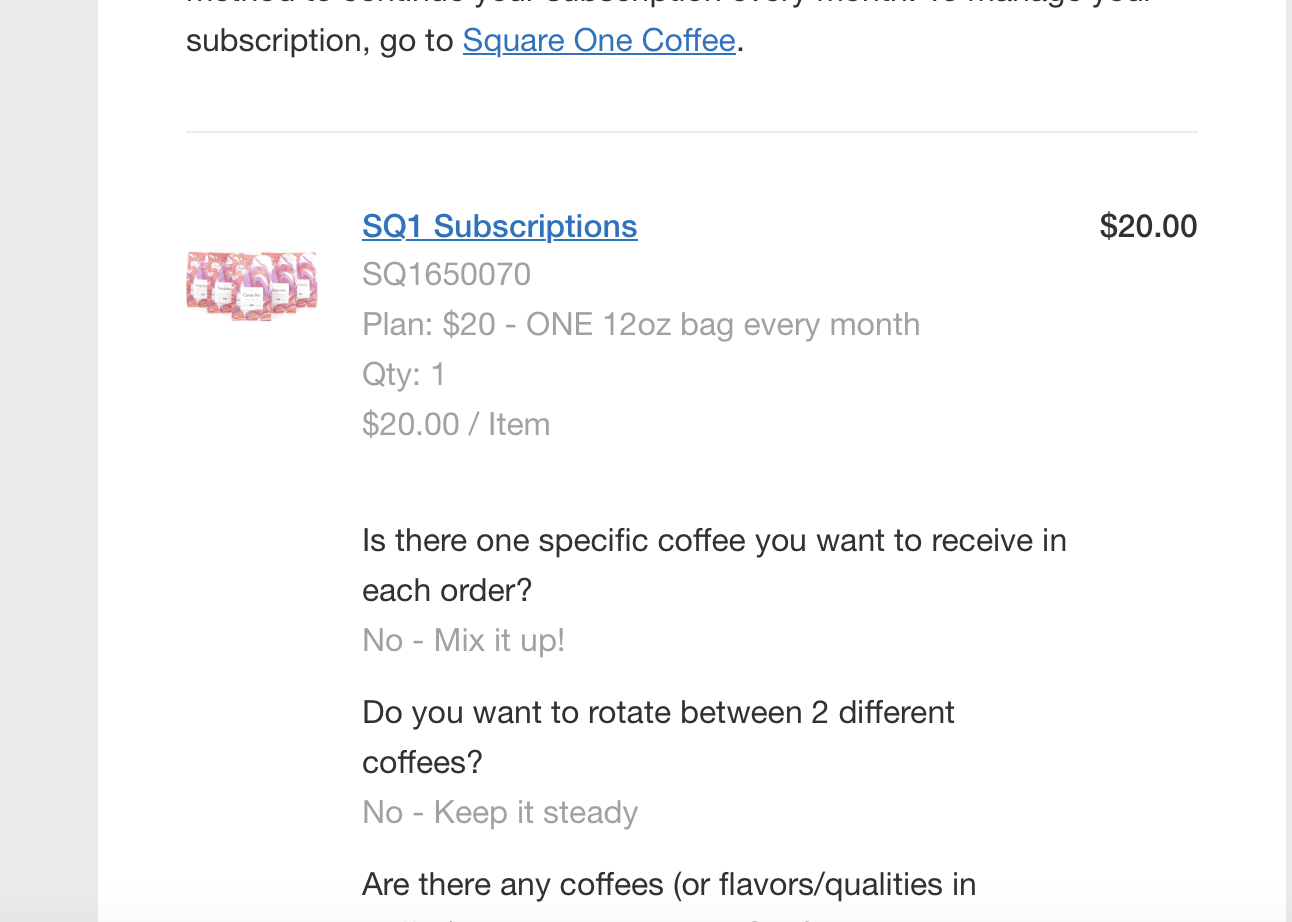
There’s nothing that grinds my gears more than a no-reply email, and there’s a reason why no-replies end up hurting the customer service experience for SMBs in the long run. To help you make sure you’re not taking the wrong turn as you drive your email campaigns, I’ll illustrate. Here’s an example:
Years ago, I bought my parents a subscription to a coffee club. They love it, which makes me love it, too. I purchased the subscription online, and the roaster sends them a different bag of beans every month. This gift covers Christmas, their birthdays, and Mother’s and Father’s Day.
Put bluntly, this service and product solves a big problem for me: I send gifts automatically and never have to worry about forgetting a special date.
Each month, the company uses email marketing automation to send me an email with offers and news. Honestly, I don’t read much of those email newsletters and announcements — but one day, I needed to get in touch. My mother told me how much she and my father love the variety of coffees, but she mentioned they wanted to save a step and use pre-ground coffee.
Remembering the roaster’s emails, I searched my email folder for the latest message. Then, I just hit the reply button. The return address was orders@squareonecoffee.com, and within a day, I had confirmation that my parents would get a bag of ground coffee instead of whole beans next month.
The interaction would have been much more complicated if the company had used a no-reply email instead. I could have received an error message that forced me to search online or perhaps through social media. I would have had to write yet another message, which would take time I didn’t have, creating a problem between the customer and the company. Maybe I would have found another roaster to subscribe to.
That’s the last thing any small business owner wants. No-reply emails are bad for business because they downgrade your customer service. Some companies use them for benefits that don’t add up once you know the reasoning behind the best practices. Thankfully, it’s easy to understand what no-reply emails are and how you can improve your email marketing strategy.
No-reply emails 101
A no-reply email is an email address that goes straight into the trash can. Depending on the email service, the sender may or may not receive an error message when they send to a no-reply email address. What does a no-reply email mean? It means no one is at the other end monitoring the inbox.
No-reply emails are set up never to be delivered. They are sometimes used to avoid getting notifications of bounced emails or auto-responders — but they usually create more headaches than they avoid. For example, your recipients will be asking, “Why am I getting emails from no-reply?”
Think about the origins of emails: You are sending a modern version of a handwritten letter. Imagine going to your home’s mailbox and finding a letter with no return address. You’ll likely wonder what is going on. No small business owner wants their customers to wonder what’s going on.
Even if you’re still mastering the answer to the question, “What is email marketing?” you should know that all messages should always be clear to your target audience.

The problems with no-reply emails
Let’s say that the coffee roaster used a no-reply email. What happens if you reply to a no-reply email? The company would never see my message. My simple request, which preserved an annual subscription and ensured a happy customer, would never be seen by the small business. It’s up to me to follow up, which may even create resentment.
I’m not the only one who finds it a pleasure to get an answer easily from a customer service representative. Your customers won’t appreciate a no-reply email simply because it’s impersonal. It doesn’t help them solve their problems, which can impact your bottom line.
As you begin to implement email marketing best practices, you’ll discover that a no-reply email can impact your return on investment (ROI). This means your outreach work will be less effective, and you may not even realize why.
Some people might think a no-reply email is an excellent way to avoid delivery challenges since, for example, companies might not care if one person on the email list is away on vacation. But that no-reply address may make your message go into people’s spam folders. It may be impossible for your customers to add your email newsletter to their safe lists, even if they want to.
Addresses that start “no reply” or something similar create an impersonal image. Having a person or even a title on the other side of the email message is much more friendly and warm. You’ll reduce miscommunication and stop the friction that no customer wants.
The misunderstood benefits of no-reply emails
Here are reasons I often hear about wanting to use a no-reply email and why those so-called benefits usually don’t occur.
Managed flow of communication
Yes, you’ll avoid having to deal with out-of-office responses, but you’ll make communication more difficult. One of the benefits of email marketing is the ability to foster and build relationships between your company and customers. When people can respond directly to a specific person, they have a direct connection that will make them more likely to do business with you again in the future.
You’ll need to designate a team member to regularly answer emails, but those email responses can be essential to the customer service experience.
Reduced spam
Perhaps you think that a no-reply email will protect your company from spam folders. That’s not the case. The best way to avoid being labeled spam is to make sure everyone on your email list opts-in to the list. When someone chooses to receive communication from a company, they are usually happy to see messages show up in their inbox.
Prioritized messages
The reality is that any question or concern coming from a customer should be answered quickly, and you should make it as easy as possible. You aren’t saving resources by adding a no-reply email because you may have to spend more time and possibly money to salvage the relationship instead.
What is a no-reply email example? Just think back to the coffee subscription for my parents. Maybe you think a small request like grinding the beans isn’t as important as other parts of the company’s operations. My subscription cancellation may just be one, but I might not be the only one — which can add up.

Protection and privacy
Perhaps your company values respect customer and employee privacy. You may think that one way to protect identities is with a no-reply email, but you can just as easily have the email come from the “director of communications” or even “customer service.” While it’s best to have a real person and name sending the emails, there are better ways to protect privacy.
How to engage with email recipients
The bottom line is that a no-reply email does not allow you to engage with your target audience. As you integrate your customer service policy with your email marketing plan, you’ll want to focus on these best practices instead.
Be relationship-centered
With each interaction you have with both loyal and potential customers, consider your relationship. Invite them to connect with you. Offer them many ways to reach out if they need help. All relationships take work — but you should be doing the work on your end to make it easier for your customers.
Manage your resources
Many business owners want to automate their marketing plans, which can be highly effective — especially when combined with personalization techniques. But it’s easy to go too far in the extreme. Few people want to talk with a bot when they can speak with a live person.
Add responses to the normal workflow
There are a lot of responsibilities that come with creating an excellent customer service experience. Creating a structured workflow for all interactions will make the process easier. This includes responding to emails.
Schedule time throughout the week to check in on your online reviews, social media, and email replies. This can ensure everyone gets a response as quickly as possible while not creating a crisis mentality. You’ll get more done if you focus on an individual task rather than try to answer every question as it arrives in your inbox.
Be proactive with support
When you have a dedicated email address for support concerns, you send a clear message to your email list members that someone will always be available to answer their questions. This satisfied me when I needed to reach out to the coffee roaster. I didn’t need an answer within 30 minutes, but I did appreciate getting a response within a day or two.
The coffee company was proactive. Instead of having to search among the competition for a new roaster, they made it easy for me to get support. I didn’t have to wonder, “Are no-reply emails legitimate?” I knew someone was there, and my parents got the ground coffee they love.
Alternatives to using no-reply emails
You likely understand the problems with using a no-reply email address, but now you may wonder about the next step. You’ll need to use something in the “reply to” section when you’re learning how to do email marketing.
Always use an actual email address that goes to a real inbox. It doesn’t have to be the direct email address of the company CEO, but it should be an address directly connected to your company. Using an email service that helps to support branding initiatives guarantees your business name is directly part of your official email address.
Next, check your company’s email deliverability to certify that all your messages are landing in your customers’ inboxes, not their spam folders. You’ll find that a no-reply email makes you look like spam, even when you’re providing helpful content your customers want.
However, you don’t want to fill your team’s inboxes with auto-responses. Use email list sign-up tools from email marketing services like Constant Contact to automate and filter the out-of-office messages. Tools can also make sure you don’t miss any unsubscribe requests or other important automated messages you do need to see.
Speaking of marketing automation, you can also create your own chatbot to communicate with anyone who reaches out to you on social media. You can also create a chatbot-style auto-response on email using Constant Contact. Even if it’s just a matter of providing a timeframe for when a person can receive a reply, it can help manage expectations in the customer service process.
Read up on additional customer service best practices so you can do everything you can to keep your audience happy and satisfied with the experiences that come with your products and services.
Do better than a no-reply email
Now that you know the alternatives for an email that lands in the trash bin, you can officially ditch the no-reply email address for your business. You’ll improve your customer service experience and make it easier for customers to return. Be as welcoming and beneficial as a piping hot, fresh cup of coffee.
To get started, have someone outside your company go through the same process as your customers. They can act like a secret shopper. Have them sign up for your email list. You should have an automated email welcome series that they can evaluate. Then, ask them to send you a question without telling your team.
See how long it takes for the person to receive an answer and ask them about their experience. Then, work with your team to improve the steps so each customer can feel as proactively supported as possible. When customers are happy, your business is more likely to grow.




